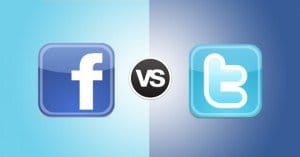 Written by ContentPowered.com
Written by ContentPowered.com
Twitter and Instagram are very different social networks, but they have one thing in common; a similar number of monthly active users. In this case, the big news this month is that Instagram hit 300 million monthly actives, and that surpasses the number Twitter posts, at 284 million.
This is a big deal for some people, and a cause for contention for others. First, let’s take a look at the different types of users who inhabit each platform.
Twitter has a smaller number of monthly actives, by a relatively minor 16 million people. While 16 million is nothing to scoff at, it’s still relatively small, particularly compared to the monthly actives on Facebook, which totals up 1,350 million, or 1.3 billion.
Twitter users tend to be heavy, active people. Twitter is not friendly to newbies or casual users; if you’re not posting a dozen times per day, you’re largely overlooked. It takes a special gimmick or a high volume to achieve success on Twitter.
Twitter’s whole gimmick, as everyone knows by now, is the 140 character limit on posts. The idea is to sum up everything you want to say in a few words, making it short, punctual and easy to digest. The problem with this is that most people, if they have more to say, just post sentences cut off between words, sometimes numbered with a (1/4) or something to indicate how many tweets go in sequence.
Instagram is a very different sort of social network. For one thing, while it doesn’t limit your posts so strictly, it’s based around an entirely different type of content; images. The basis for Instagram is a mobile app. The idea is that you take pictures with your phone, run them through the basic filters Instagram makes available, write a quick description and post them up.
Of course, even though Instagram has made it as difficult as possible to use the platform via desktop, most businesses still use desktops to do the work. They either use a third party upload service, or just push images to their phones once they have been edited to perfection.
Instagram caters more to a younger, casual audience, particularly those who are more visually inclined. It also has some of the highest engagement rates on any social network, by a very wide margin.
This is in comparison to Twitter, which has a much older audience. Twitter also boasts a huge number of professionals in various industries, from CEOs and top executives to sports and movie stars, to politicians and social activists. In fact, Twitter is a hub through which many social justice movements have operated throughout the last few years.
Which is Better for Marketing?
The question posed in the title should be addressed in the article, after all. So which would you pick? Honestly, if you had to pick only one, right now it’s a tough call. Thankfully, it’s easy enough to pick both of them.
Twitter for marketing is tough. You have to compete with an absolute tidal wave of content being posted at any given time, and Twitter doesn’t curate the user’s experience the same way Facebook does. In fact, messages are largely displayed in chronological order; if you post too late or too early, you’ll miss your audience entirely.
Marketing through Twitter also requires a light touch. If you’re posting blatantly advertorial messages constantly, no one is going to follow you. It’s even worse than Facebook, where you can at least add a basic marketing CTA into a longer post about a different overall topic. On Twitter, you only have a single sentence to make your point, and you can’t hide a marketing message.
Twitter does have the benefit of some potentially very potent audiences. If you were to gain the attention of one of the aforementioned celebrities, you can suddenly have your message put before millions of people. There aren’t any power users quite as powerful on Instagram, at least not yet.
Twitter also has the benefit of hashtags, which are a uniquely Twitter-ian feature. Other sites have implemented them, for better or for worse, but they work best on their original home. You can create a hashtag or take part in the discussions going on in one.
Twitter does have one major downside; it’s incredibly easy to say the wrong thing at the wrong time and have your entire business go down the tubes. Mistakes aired on Twitter are aired forever, even if you delete the tweet.
Instagram is a little different. For one thing, it’s become a haven for certain types of marketers. See, Instagram has a few options that allow it to include details that turn it into a storefront. You can actually use pictures of your products as sales pages, to convert users directly. You don’t need to refer them through to your storefront and your own conversion process.
On the other hand, Instagram requires a business that can cater to younger audiences. The typical Instagram user is young, so your business selling industrial sprockets to widget manufacturers isn’t going to find customers on the platform.
Instagram does have one significant barrier, which is that the site is difficult to use without going directly through a smartphone. There’s no real API to allow third party services, like HootSuite or Buffer, to post to the site for you. You need to use third party services that take your username and password, and literally use their own mobile devices to post your forwarded messages for you.
Instagram engagement, as mentioned before, is insanely high. If you’re looking for a deep connection with your fans, that’s the place to get it, and you better get it quick. News about their engagement rates broke back in April, and it has spread since. Marketers are flooding the place, and sooner or later, users will begin to turn away. It’s still a bit of a golden opportunity, but only if you’re in the right niches.
Which should you choose? Twitter, with the networks of professionals and superstars, or Instagram, with high engagement among teenagers? While it largely depends on your ideal audience, it can’t hurt you to operate on both fronts.

I never thought I’d see the day. I guess Facebook made a good investment. Instagram needs a desktop version badly